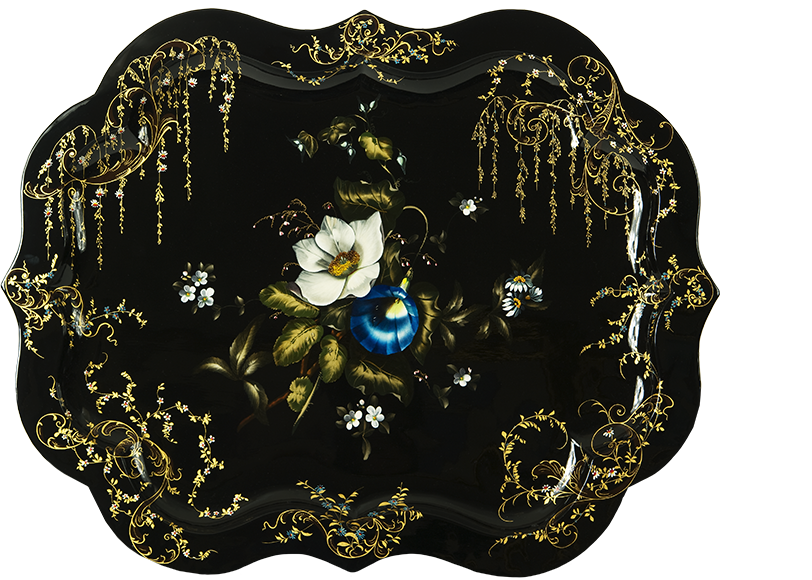
Victorian Flower Painting
This decorative painting technique was popular during the 1837-1901 reign of Queen Victoria and appeared on trays, hand screens, boxes, furniture, and other items of exceptional merit made of metal, papier mâché and wood. Flowers, birds, especially birds of paradise, peacocks, fountains and fruits are realistically rendered with layered base coats and transparent paints adding color and great depth. The brightest highlights are added last, usually with white. Mother of pearl is frequently found in these designs, and a bronzed background is often included. The painting is typically framed with an arabesque scroll, which can be any combination of paint, freehand bronze, and/or gold leaf.
Pontypool Painting
Pontypool painting is a style of decoration which originated in Pontypool, Wales along with their signature pierced-edged trays of various shapes and sizes. The style usually composed of flowers, fruits and birds that show great form and depth by contrasting strong textured highlights against deep shadow. Brushstrokes are textured and clean, and colors are rich and bold. Extremely fine gold leaf borders are characteristic.

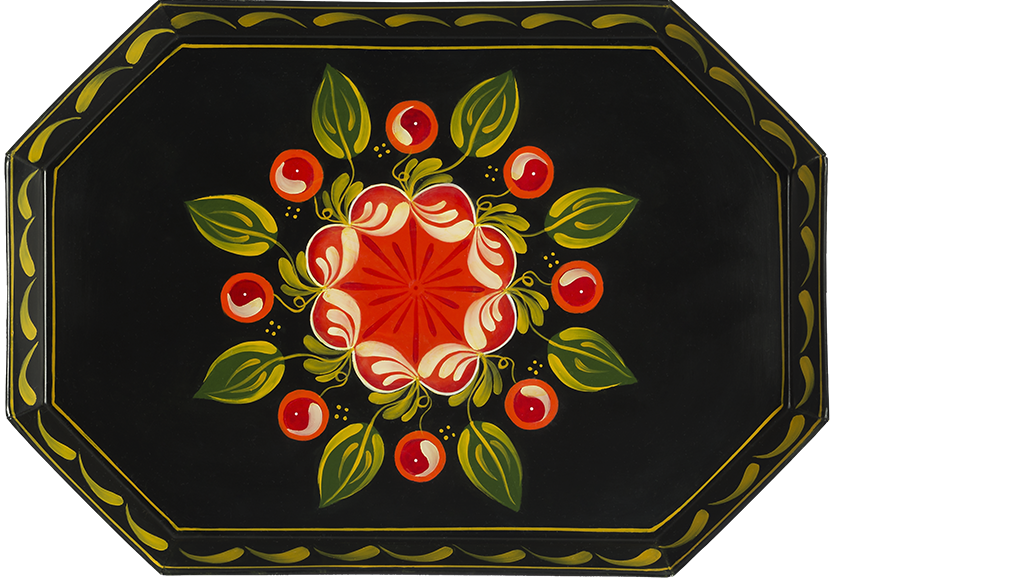
Country Painting on Tin
American tinsmiths started painting their tin to make it more durable and added brushstroke painting to make it more attractive to buyers. Tin centers in Connecticut, Maine, New York and Pennsylvania sent out tinkers to sell their wares door to door. Items for sale included trays, boxes, coffee pots, cups, tea canisters, trunks, and other useful housewares. This highly stylized form of decoration was usually characterized by strong base coats and translucent overstrokes. Motifs proliferated as tin shops developed their own designs and painting style, leaving us today with an extensive catalog of designs, some still waiting to be discovered and appreciated.
Freehand Bronze
Freehand bronzing is the application of metallic powders to a tacky varnish base coat, creating designs comprised of flora, fauna, and pastoral scenes. Usually found on trays made of metal and papier mâché, this method of decoration was done in the English Midlands of the 18th and 19th centuries. A popular export product, the technique often employed metal leaf accents and overpainting for visual interest.
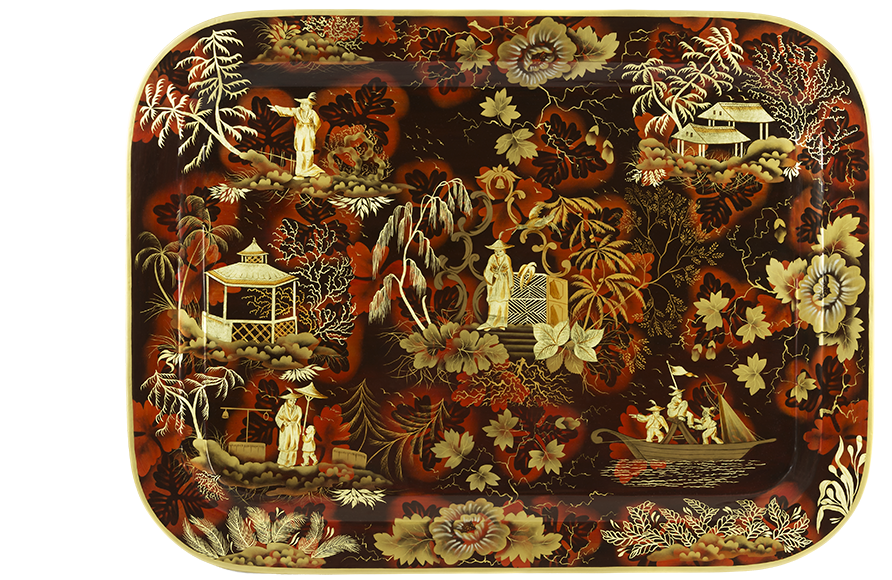

Bronze Powder Stenciling on Wood and Tin
This technique is similar to free hand bronze in that the powders are applied to a tacky varnish base coat, but differs in that those same powders are applied to the base coat through a stencil, giving it an entirely different look. Stenciling on wood was done on chairs, boxes, cornices and creates the illusion of a third dimension by skillful, smooth shading. One unit may have more than one color of bronze powder to help show dimension. Tin stenciling is “tighter” than wood stenciling, which means that the motif behind a given unit shades more gradually than stenciling on wood, almost approaching the unit that appears to be in front of it. The designs typically done on metal trays, bread baskets and boxes, are usually very well balanced with units repeated several times to form the design. Stenciling sometimes has metal leaf, color washes and painting incorporated into the design.
Metal Leaf Painting
Metal leaf painting is the application of gold leaf onto a tacky varnish base coat. Metal leaf can be used as a stand alone technique but can also be found with stenciling on tin, stenciling on wood, freehand bronze, Pontypool and Victorian flower painting. Metal leaf is often etched or painted with fine black brushwork to define form and add details. Washes of transparent color add shading.
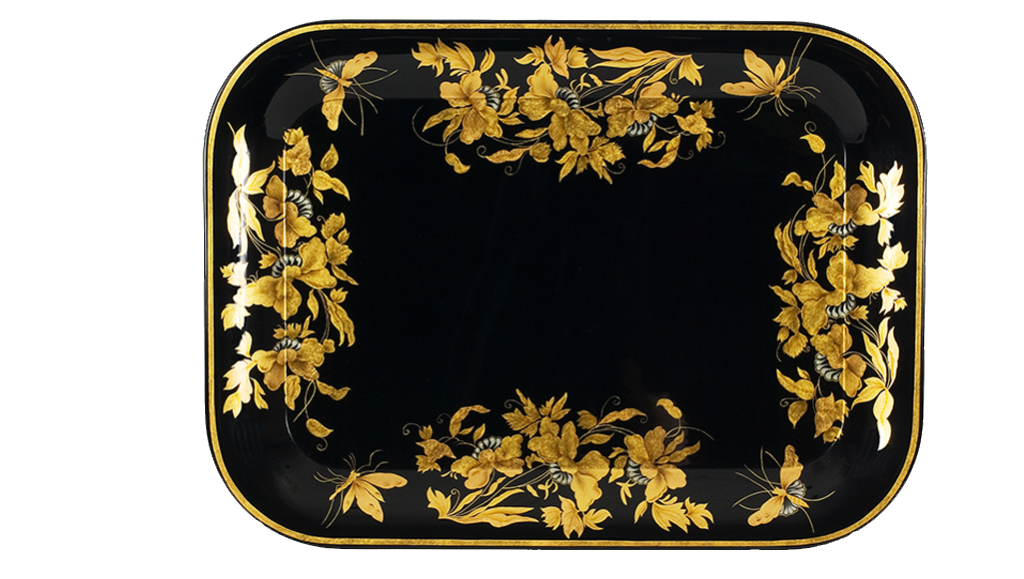
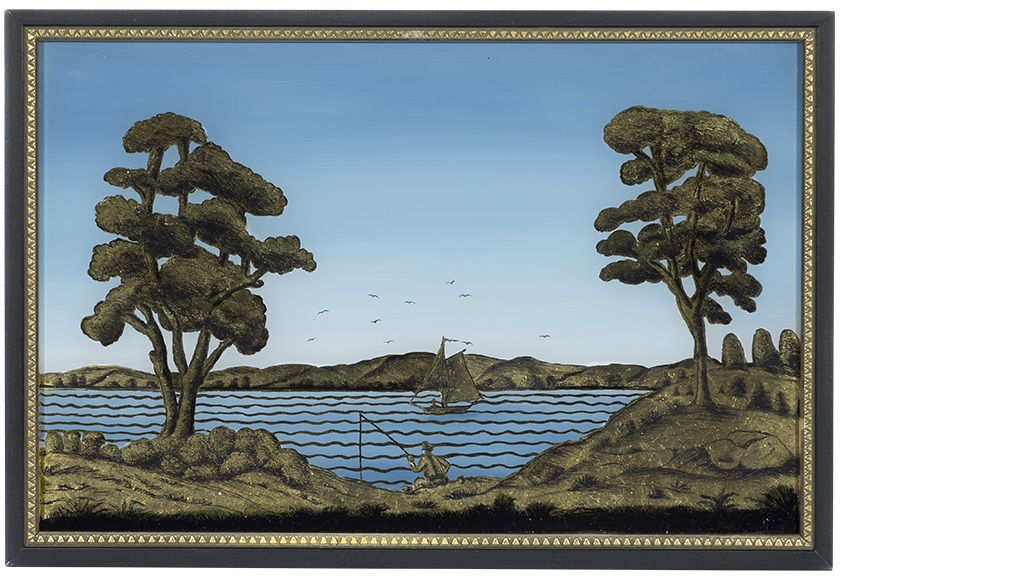
Reverse Painting and Gilding on Glass
Reverse glass painting involves creating a mirror image of a picture on a piece of glass. The foreground is painted first and the background last, so that the image can be viewed correctly on the opposite side of the glass. The reverse painting technique is often combined with gilding on glass, which involves applying metal leaf to the back of the glass using gelatin and water size. Once the metal leaf is laid down, a design is etched on the metal leaf and then backed with black paint. The surplus leaf is then washed away, and the rest of the glass is painted using the reverse painting technique.
In early America, designs ranged from country scenes and sailing ships, to historical events. Portraits of George Washington were common. Many reverse-glass panels were used to decorate looking glasses and tablets in clocks. Empire-style panels for mirrors usually had borders of gold leaf, fine stencil designs, or both, surrounding painted landscapes, fruit, and naval scenes.
Clock Dials
The arched clock dial was introduced in the mid-1700’s and as tall case clocks became ever fancier, so did the painting on their faces. Floral, scenic, pastoral or nautical themes were common as were hunting scenes and mythological figures. Painted moon dials were incorporated into the movement to depict the lunar cycle.
Painting a clock dial requires a variety of skills. Gilding, oil painting, the use of gesso to create raised elements, plus the creation of an inked time track are all separate skills that must be acquired to master this decorative art form.
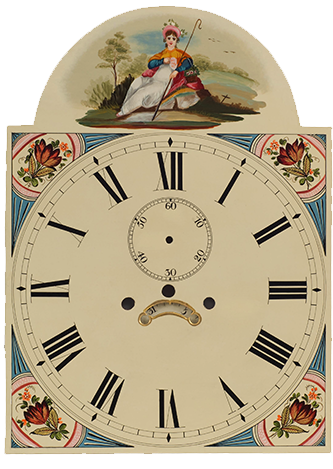
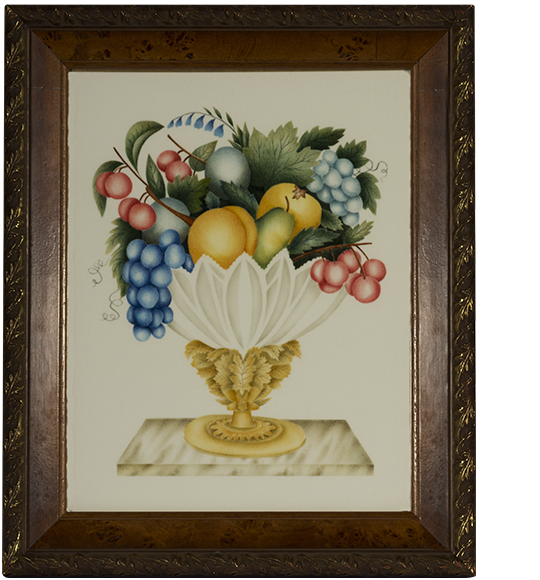
Theorem Painting
Theorem Painting is referred to as a mechanical method of painting a picture by applying paint through a series of stencils or “theorems.” Theorem refers to the stencils used, not to the painting itself. It is sometimes called velvet painting as the theorem technique of painting was often applied to velvet (cream or off-white color), paper, silk, cotton, linen, and light colored wood. Still life compositions of fruits and flowers were the most common subjects, along with birds, and butterflies. Landscapes, biblical scenes and mourning pictures were popular from the Early 19th century through the Victorian era. Small, stiff brushes are used and sometimes a finger wrapped with a small piece of wool or velvet is used to create a subtle shading effect. Theorem paintings are painted either in oils or watercolors. Velvet painting came from England and was most popular from 1820-1860. It is sometimes referred to as Poonah painting, from Poonah, India because the “poonah” brush was used. It can also be referred to as Chinese painting because the Chinese stenciled on pith, a paper-like substance with a velvety texture.
In early America, designs ranged from country scenes and sailing ships, to historical events. Portraits of George Washington were common. Many reverse-glass panels were used to decorate looking glasses and tablets in clocks. Empire-style panels for mirrors usually had borders of gold leaf, fine stencil designs, or both, surrounding painted landscapes, fruit, and naval scenes.
Penwork
This art form was popular in Britain during the Regency and Georgian periods. Its effect was to emulate the look of the expensive ebony and ivory inlaid pieces from Vizagapatam, India. Penwork was accomplished by young ladies at home, although there was also a market of professionally-decorated items. Designs were executed with pen and ink on items made of white wood (sycamore, yew, pine, etc.) that had minimal grain.
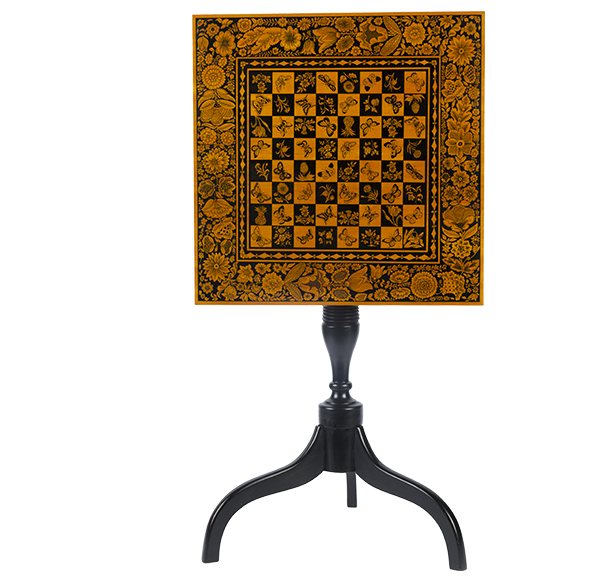
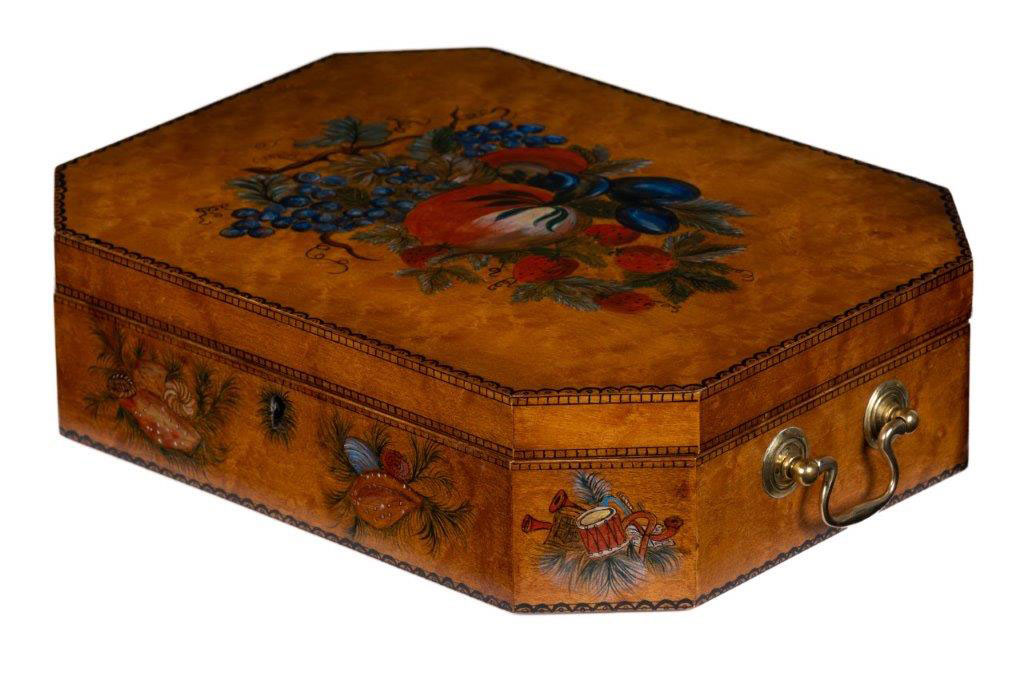
Women’s Painted Furniture
Women’s Painted Furniture (WPF) was a practical art taught to young ladies of means throughout New England between 1790-1830 in academies or by private instruction by traveling decorative artists. This work was done on finely figured American woods such as curly maple, cherry, and satinwood as well as poplar and pine and was meant to both display the young lady’s ability to decorate the home and to provide gifts of a highly personal nature.
This form of American Schoolgirl Art was accomplished using casein paints and inks with pen and brush, depicting scenes of home, landscape, family, flowers, fruit, insects and other images of nature. Many decorations adorned small tables, boxes and face screens and were often accompanied by prose.
Artistic skill was varied, as was the workmanship of the local cabinetmaker available to the girls. Pieces produced by some professional decorative artists and well-known cabinetmakers were more uniform in quality.
